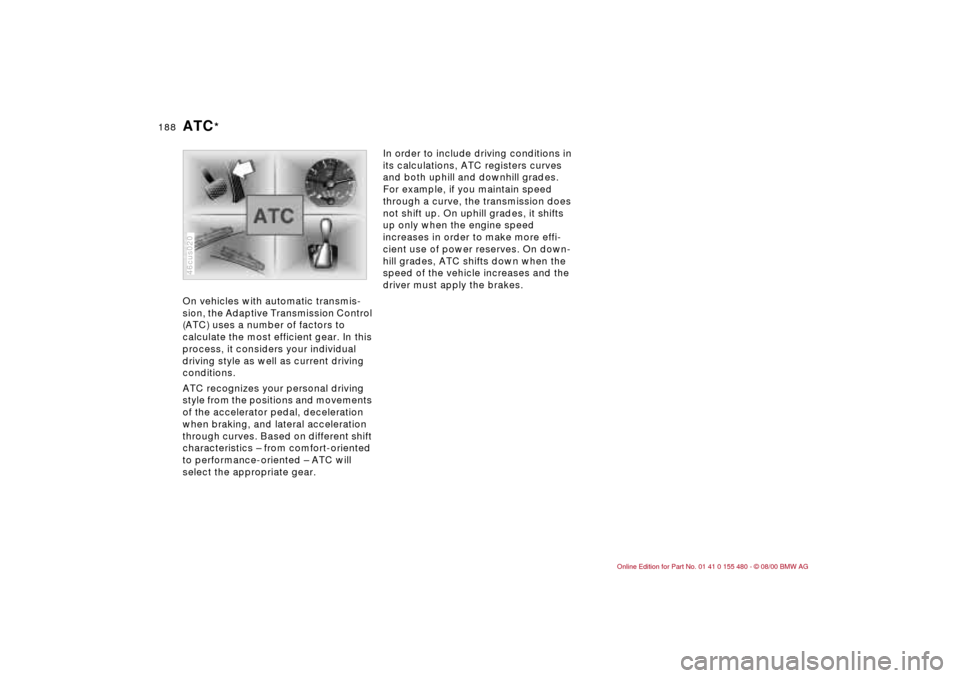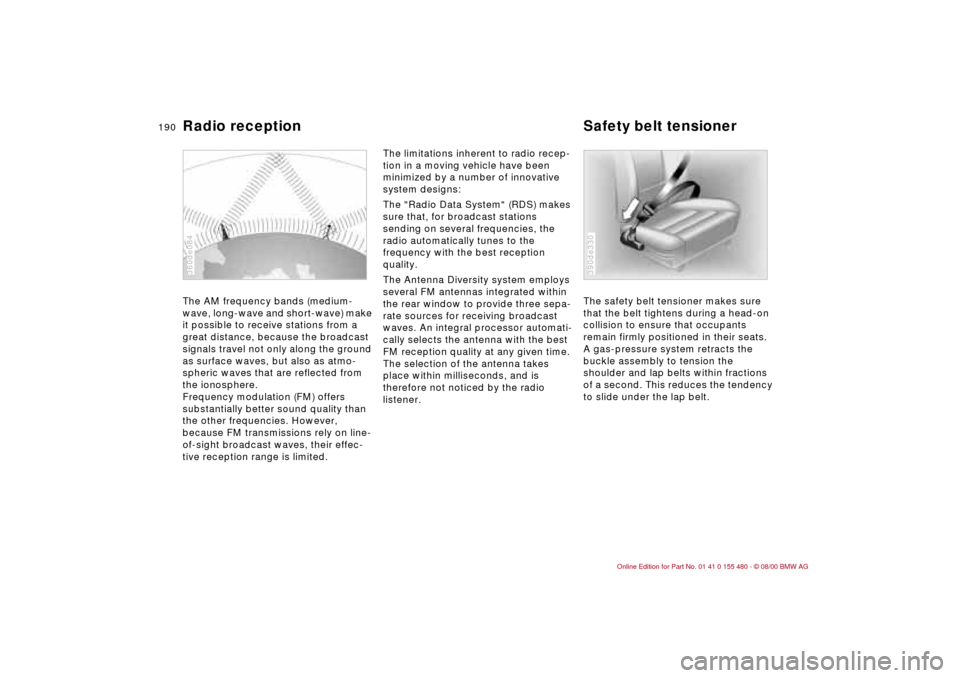Page 145 of 215

145n
IndexDataTechnologyRepairsCar careControlsOverview
Engine oilChecking the oil level 1 Park the vehicle on a level surface.
2 Shut the engine off after it has
reached normal operating tempera-
ture.
3 After approx. 5 minutes, pull the
dipstick out and wipe it off with a
clean lint-free cloth, paper towel, or
similar material.
4 Carefully push the dipstick all the way
into the guide tube and pull it out
again.
5 The oil level should be between the
two marks on the dipstick.
As with fuel economy, oil consumption
is directly influenced by your driving
style and vehicle operating conditions.462de244
The oil volume between the two marks
on the dipstick corresponds to approx.
1.1 US quarts (1 liter). Do not fill beyond
the upper mark on the dipstick. Excess
oil will damage the engine.460de189
To add oil Wait until the level has dropped to just
above the lower mark before adding oil.
However, never let the oil drop below
the lower mark.
BMW engines are designed to
operate without oil additives; the
use of additives could lead to damage
in some cases. This is also true for the
manual transmission, the automatic
transmission, the differential and the
power steering.<462de245
Page 173 of 215

173n
IndexDataTechnologyRepairsCar careControlsOverview
Changing a wheel
Take these precautionary
measures if you have either a flat
tire or are changing the tire:
Stop the vehicle as far as possible from
passing traffic. Park on a firm, flat
surface. Switch on the hazard warning
flashers. Turn the steering wheel to the
straight-ahead position, remove the key
and engage the steering lock. Shift into
1st or reverse gear (selector lever in
"Park" with automatic transmission) and
engage the parking brake.
All passengers should be outside the
vehicle and well away from your imme-
diate working area (behind a guardrail,
for instance).
Set up a warning triangle
* or portable
hazard warning on the roadside at an
appropriate distance from the rear of
the vehicle. Comply with all safety
guidelines and regulations.
Change the wheel only on a level, firm
surface which is not slippery. Avoid
jacking the vehicle on a soft or slippery
support surface (snow, ice, loose
gravel, etc.), as it could slide sideways.
Position the jack on a firm support
surface.
Do not place wooden blocks or similar
objects under the jack. If this is done,
the jack might not be able to reach its
full support capacity because of the
limited height.
Do not lie under the vehicle or start the
engine when the vehicle is supported
by the jack. Failure to comply with this
creates a risk of fatal injury.<
Your BMW has a space-saver spare tire
for temporary use to ensure your
mobility.
To remove the space-saver spare
tire, take out the floor panel in the
luggage compartment completely (refer
to page 41).<
You will need the following:In order to avoid rattling noises later,
note the position of the tools when you
remove them and return them to their
original position when you are through
using them.
>Jack (1)
Raise the floor panel in the luggage
compartment (refer to page 41) and
unclip the jack from where it is stored
(arrow).
After use, swing the crank back and
clip into place.
>Wedge (2)
Located behind the jack on the wall
in the luggage compartment. Loosen
the wing nut to remove it.46cde038
Page 187 of 215
Overview
Controls and features
Operation, care
and maintenance
Owner service procedures
Technical data
Index Advanced technology
187n
IndexDataTechnologyRepairsCar careControlsOverview
Adaptive Transmission Control
(ATC)188
Airbags189
Automatic Stability Control plus
Traction (ASC+T)/Dynamic
Stability Control (DSC)189
Radio reception190
Safety belt tensioner190
Interior rearview mirror
with automatic dimming
feature191
Rain sensor191
Tire Pressure Control (RDC)192
Self-diagnostics192
Rollover protection system193
Xenon lamps193
Technol-
Page 188 of 215

188n
On vehicles with automatic transmis-
sion, the Adaptive Transmission Control
(ATC) uses a number of factors to
calculate the most efficient gear. In this
process, it considers your individual
driving style as well as current driving
conditions.
ATC recognizes your personal driving
style from the positions and movements
of the accelerator pedal, deceleration
when braking, and lateral acceleration
through curves. Based on different shift
characteristics Ð from comfort-oriented
to performance-oriented Ð ATC will
select the appropriate gear.
46cus020
In order to include driving conditions in
its calculations, ATC registers curves
and both uphill and downhill grades.
For example, if you maintain speed
through a curve, the transmission does
not shift up. On uphill grades, it shifts
up only when the engine speed
increases in order to make more effi-
cient use of power reserves. On down-
hill grades, ATC shifts down when the
speed of the vehicle increases and the
driver must apply the brakes.
ATC
*
Page 190 of 215

190n
Radio reception Safety belt tensionerThe AM frequency bands (medium-
wave, long-wave and short-wave) make
it possible to receive stations from a
great distance, because the broadcast
signals travel not only along the ground
as surface waves, but also as atmo-
spheric waves that are reflected from
the ionosphere.
Frequency modulation (FM) offers
substantially better sound quality than
the other frequencies. However,
because FM transmissions rely on line-
of-sight broadcast waves, their effec-
tive reception range is limited. 360de084
The limitations inherent to radio recep-
tion in a moving vehicle have been
minimized by a number of innovative
system designs:
The "Radio Data System" (RDS) makes
sure that, for broadcast stations
sending on several frequencies, the
radio automatically tunes to the
frequency with the best reception
quality.
The Antenna Diversity system employs
several FM antennas integrated within
the rear window to provide three sepa-
rate sources for receiving broadcast
waves. An integral processor automati-
cally selects the antenna with the best
FM reception quality at any given time.
The selection of the antenna takes
place within milliseconds, and is
therefore not noticed by the radio
listener.The safety belt tensioner makes sure
that the belt tightens during a head-on
collision to ensure that occupants
remain firmly positioned in their seats.
A gas-pressure system retracts the
buckle assembly to tension the
shoulder and lap belts within fractions
of a second. This reduces the tendency
to slide under the lap belt.
390de330
Page 192 of 215

192n
Tire Pressure Control* Self-diagnostics This system regularly checks tire pres-
sure and monitors all four tires even
while driving, so you do not have to.
Behind the valve stem in every wheel,
there is an extended-life electronic chip
that contains a pressure sensor, a
transmitter and a battery. The pressure
is measured in extremely short time
intervals and then transmitted by a
radio signal. If an irregularity is
detected, the transmission rate is
increased.
Located near each wheel and
embedded in the vehicle body is an
antenna that receives signals from the
wheel. A central electronics system
evaluates the quadruple signals and
forwards any changes.
The RDC provides an important contri-
bution to driving safety.46cde078
All
of the important electrical and elec-
tronic systems in the vehicle are tested
regularly and automatically Ð the driver
does not have to perform any extra
operations or adjustments.
The indicator lamps come on brießy
after the ignition has been turned on, for
example.
While you are driving, the functional
status of the actuator motors (for the
windshield wipers, power windows,
seats, etc.) is constantly being analyzed
by electrical measurements in the relays.
In the same manner, the electrical
resistance of the airbag ignition genera-
tors and all of the remaining airbag
components is measured at all times. Any
fault in this system would be detected
immediately by a current ßuctuation that 46cde052
would necessarily accompany it.
The fault
would be indicated immediately by the
airbag warning lamp.
Even after you shut off the engine, the
overall functional status of your vehicle is
monitored. For example, all of the ßaps of
the heating and ventilation system travel
to the nearest limit position. This action
ensures that the system will be able to
provide defrosting, regardless of other
circumstances, e. g. if a malfunction in the
air conditioner/automatic climate control
system
* should occur during the night
while the vehicle is parked.
A calibration cycle runs every tenth time
the engine is shut off. During this cycle,
the actuator motors of all the heating and
ventilation ßaps travel to their limit stops
in both directions. The limit positions and
the return travel paths are checked in this
manner in order to ensure that appro-
priate adjustments for the operating
elements can be made at any time.
You will hear the sounds of the air ßaps as
the air conditioner/automatic climate
control* carries out its self-diagnostic
functions after the ignition has been shut
off. All of the other self-diagnostics func-
tions operate silently in the background.
Any possible faults detected during these
self-diagnostics can be read out and
corrected by your BMW center
during the
next regularly scheduled maintenance.
Page 198 of 215
198n
Weights
BMW 325Ci BMW 330Ci
Curb weight (with one person, ready for operation, full tank of fuel, options not included)
with manual transmission
with automatic transmissionlbs. (kg)
lbs. (kg)3,560 (1,615)
3,627 (1,645)3,627 (1,645)
3,704 (1,680)
Approved gross vehicle weight
with manual transmission
with automatic transmissionlbs. (kg)
lbs. (kg)4,442 (2,015)
4,509 (2,045)4,508 (2,045)
4,586 (2,080)
Approved front axle weight lbs. (kg) 2,072 (940) 2,094 (950)
Approved rear axle weight lbs. (kg) 2,546 (1,155) 2,602 (1,180)
Approved roof weight for the hardtop lbs. (kg) 165 (75) 165 (75)
Luggage compartment capacity
with the convertible top compartment raisedcu ft (l)
cu ft (l)9.2 (260)
10.6 (300)9.2 (260)
10.6 (300)
Approved axle loads and approved gross vehicle weight may not be exceeded.
Page 199 of 215
199n
IndexDataTechnologyRepairsCar careControlsOverview
Capacities
Notes
Fuel tank
Reserve gal. (liters)
gal. (liters)approx. 16.6 (approx. 63)
approx. 2.1 (approx. 8)Fuel specification: page 27
Windshield/headlamp washer system quarts (liters) approx. 5.6 (approx. 5.3) Specifications: page 144
Cooling system including heater circuit quarts (liters) approx. 8.9 (approx. 8.4) Specifications: page 147
Engine oil filter change quarts (liters) approx. 6.9 (approx. 6.5) BMW High Performance
Synthetic Oil
Specifications: page 146
Manual and automatic transmission, transfer box
and differentialÐ Lifetime fluid, no fluid
change required